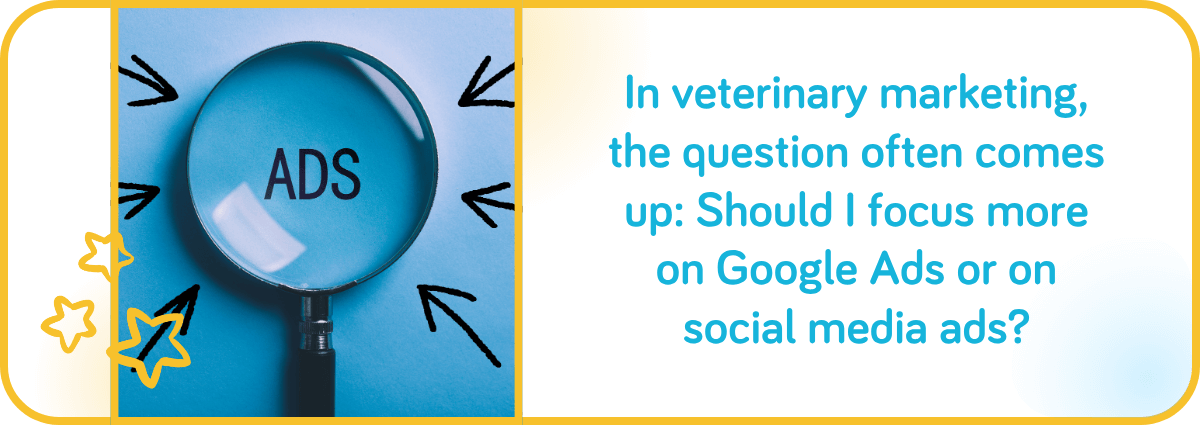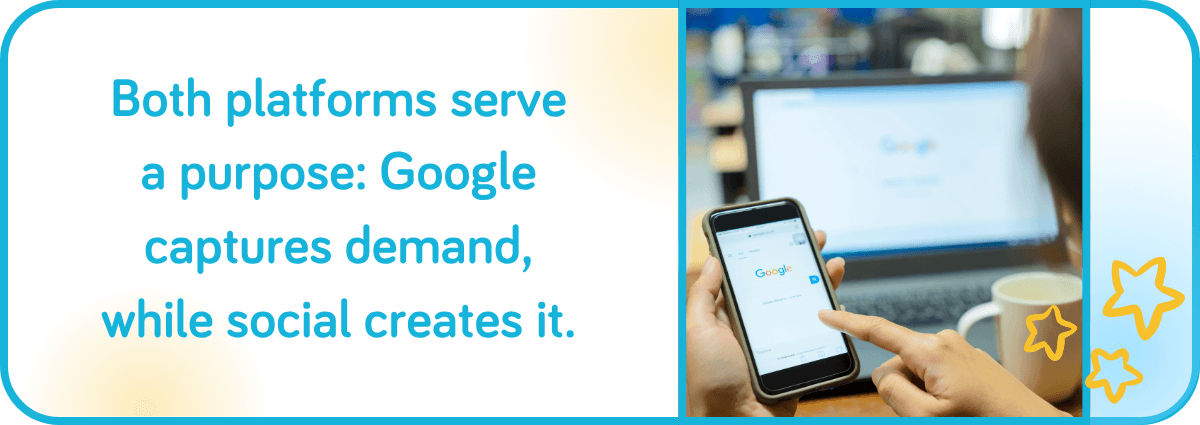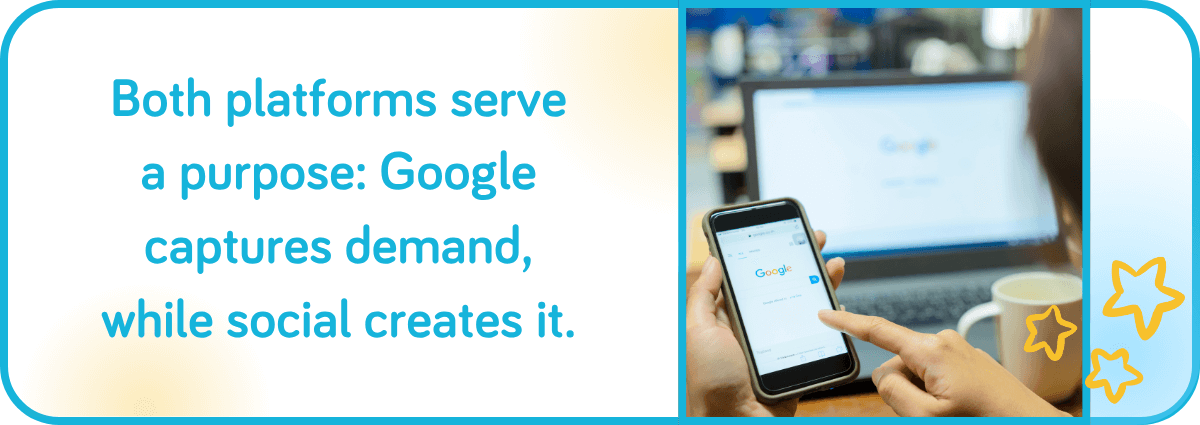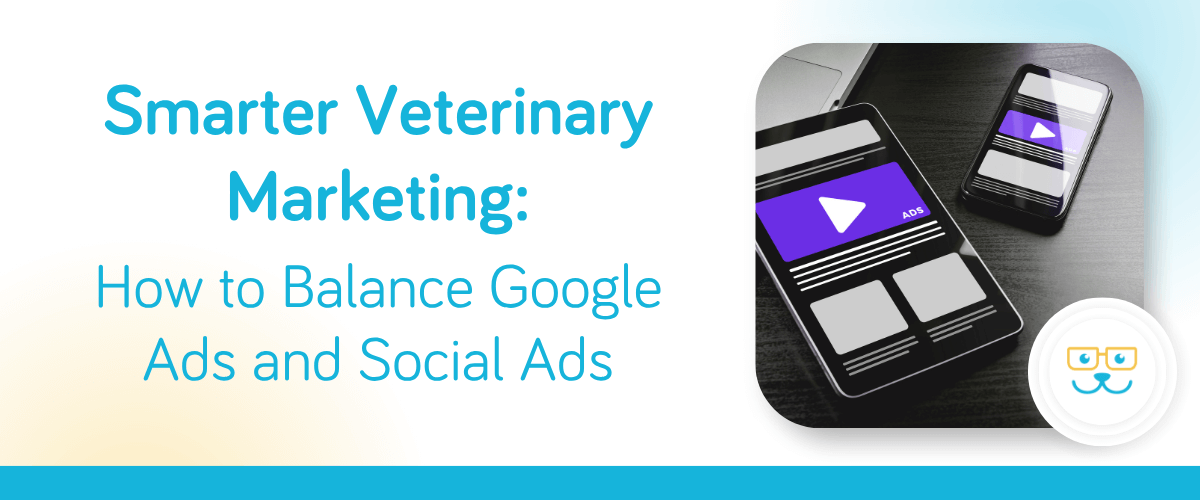Smarter Veterinary Marketing: How to Balance Google Ads and Social Ads
You’ve heard the saying: Don’t put all your eggs in one basket. The same is true for digital ads (or advertising). Many practices lean too heavily on a single channel, only to discover that their results plateau, or worse, decline over time.

In veterinary marketing, the question often comes up: Should I focus more on Google Ads or on social media ads? Ask a Google Ads manager and they’ll tell you Google is king. Ask a social media specialist, and they’ll insist you can achieve just as much through Facebook or Instagram.
The truth? Both matter, and both play distinct but complementary roles in your hospital’s growth.
Why Your Practice Needs Both Social Media And Google Ads
For most service-based businesses, the customer journey begins online. Whether it’s a restaurant, auto shop, dental office, or veterinary hospital, people start with a search. That’s why your practice needs to appear on page one of Google. And here’s a fact you can’t ignore: ads appear before organic search results, even if you already rank #1.
That alone makes Google Ads an essential part of your strategy. They give you immediate visibility when pet owners search for local services, from “veterinarian near me” to “dog dental cleaning” or “cat vaccinations.”
But here’s the catch: while search gets you in front of pet owners at the moment they need you, social media is where they spend their time every day. There are roughly 253 million Facebook users and 171 million Instagram users in the U.S. Most of your ideal clients aren’t actively searching for veterinary care daily, but they are scrolling, posting, and engaging on social media. That’s where you have the chance to build awareness, establish trust, and stay top-of-mind until they’re ready to book.

Both platforms serve a purpose: Google captures demand, while social creates it.
The Differences Between Google Ads and Social Ads
Google Ads
Google offers a couple of core ad types that are especially relevant for veterinary practices:
- PPC (Pay-Per-Click): These are the text ads that appear at the top of Google search results. You only pay when someone clicks, which makes this highly effective for driving appointment requests, especially for new client acquisition.
- Remarketing Ads: Have you ever visited a website and later noticed its ads following you across other sites? That’s remarketing. For veterinary practices, it’s an affordable way to remind potential clients who visited your site that you’re here when they’re ready to act.
Social Ads
Social media ads, meanwhile, are native to platforms like Facebook, Instagram, and LinkedIn. They don’t rely on search intent; instead, they target people based on interests, demographics, and behavior.
- Meta Ads (Facebook + Instagram): These are excellent for brand awareness, special promotions, and community building. Boosted posts, where you take an organic post and pay to reach more people, are an easy entry point that can extend your reach significantly at a low cost.
- LinkedIn Ads: While more expensive, they’re useful for recruitment and professional positioning. They can also double as a way to reach pet owners with informative content, though the cost per click is typically higher.
- YouTube & TikTok Ads: Video ads are powerful but in veterinary marketing, they typically serve as supplementary awareness channels rather than high-conversion drivers, at least for now.
The Benefits of a Combined Strategy
When you run only Google Ads, you may get clicks, but you’re missing the chance to nurture relationships and build brand familiarity before that moment of need. On the other hand, if you only run social ads, you’re missing those high-intent searches where pet owners are actively seeking veterinary care.
Together, they amplify one another:
- Brand Recall: It takes an average of seven touches before a consumer recalls a brand automatically. Social ads can provide many of those touches at a low cost, keeping your name familiar so when they search later, they’re more likely to click your Google Ad.
- Full-Funnel Coverage: Social helps with awareness and consideration; Google captures decision-making and action.
- Recruitment & Reputation: Google Ads can promote your services; social can highlight your culture, staff, and unique value, critical for both hiring and client loyalty.
What’s the Formula?
The right formula depends on your goals, budget, and community, but here are some guiding principles:
- Start with Your Budget and Goals.
How many new clients do you want to bring in each month? Are you focused on new client acquisition, or on retaining existing ones and growing service uptake? - Prioritize Google Ads for Client Acquisition.
Allocate a larger portion of your budget here if your priority is attracting new clients. Use remarketing to make every website visitor count. - Use Meta Ads for Awareness and Retention.
Organic reach is limited, so paid campaigns give you consistent visibility. Instead of spending hours creating extra posts, invest those resources into campaigns that actually get seen. - Tap Into LinkedIn for Recruitment and Professional Branding.
Promote job opportunities, CE highlights, or behind-the-scenes stories about your hospital’s culture. Run campaigns during active recruitment periods to attract the right candidates. - Track and Adjust.
Look at metrics beyond clicks: cost per new client, lifetime value, and appointment conversions. Reallocate budget as you see which campaigns deliver the strongest return.
GeniusTip: Keep posting on social media and working on adding your website content for SEO. Ads are not a replacement, but they help to boost your efforts.
Practical Examples for Veterinary Practices
- Service Promotion: Want to grow dentals? Run Google Ads targeting “dog teeth cleaning near me” while boosting posts that highlight before-and-after photos of your patients.
- Recruiting: Need an associate veterinarian? Run a LinkedIn campaign showcasing your culture, paired with a Facebook video featuring staff testimonials.
- Wellness Packages: Use Meta ads to highlight seasonal promotions (such as preventive care bundles), then remarket to those who clicked but didn’t book.
Smarter Spending = Better Returns

Veterinary marketing budgets aren’t limitless. Every dollar you spend should be tied to measurable outcomes. By spreading your investment across both Google Ads and social ads, you’re not only protecting yourself from over-dependence on one channel, but also building a stronger, more resilient growth engine for your hospital.
At GeniusVets, our PPC strategies are built specifically for veterinary practices. We’ve tested what works, eliminated what doesn’t, and developed a system that lets your team focus on what matters most—caring for pets and clients—while we handle the complexity of digital ads.
Ready to See Where You Stand?
If you’re curious how your current strategy measures up, start with a free Veterinary Marketing Health Exam. Our consultants will provide a personalized look at your digital presence, identify areas of opportunity, and give you actionable steps to take your marketing to new heights, whether or not you choose to partner with us.
Take the guesswork out of your advertising. Schedule your free Marketing Health Exam today.

